Sustainability of Railway Undertaking Services with Lean Philosophy in Risk Management—Case Study
Abstract
1. Introduction
2. Background
2.1. A Railway Undertaking on a Transport Market and the Sustainability of Services
2.2. Lean Philosophy and its Relation to Services of Railway Passenger Transport
2.3. Train Delays in the Railway Operation and Risk Management
3. Materials and Methods
3.1. Data Analysis and Processing
3.2. Development of the Research Questions and Hypotheses
4. Results and Discussion
4.1. Research of Hypothesis H1
4.2. Research of Hypothesis H2
- H0: The times of delays in individual stations are mutually independent.
- H1: The times of delays in individual stations are mutually dependent.
4.3. Research of Hypothesis H3
4.4. Research of Hypothesis H4
- H420: On the basis of the association, the delays noticed on weekdays are mutually independent in individual stations (correlation coefficient = 0).
- H421: On the basis of the association, the delays noticed on weekdays are mutually dependent in individual stations (correlation coefficient is not 0).
4.5. Research of Hypothesis H5
4.6. Research of Hypothesis H6
4.7. Research of Hypothesis H7
4.8. Software Tool
4.9. Discussion
5. Conclusions
Author Contributions
Funding
Conflicts of Interest
References
- Sommerauerova, D.; Chocholac, J.; Hyrslova, J. Sustainable development indicators of selected European countries in the field of transport sector. In Proceedings of the 22nd International Scientific Conference Transport Means, Trakai, Lithuania, 3–5 October 2018; pp. 645–650. [Google Scholar]
- Stefancova, V. Implementation of Six Sigma methodology in railway processes. Ph.D. Thesis, University of Zilina, Žilina, Slovakia, 2019. [Google Scholar]
- Morgan, J.; Brenig-Jones, M. Lean Six Sigma for Dummies, 3rd ed.; John Wiley & Sons: London, UK, 2016; p. 350. [Google Scholar]
- Cempirek, V.; Vrbova, P.; Zakorova, E. The Possibility of Transferring the Transport Performance on Railway Transport. In Proceedings of the 18th International Scientific Conference-Logi, 8 November 2017; Volume 134. [Google Scholar] [CrossRef][Green Version]
- Nedeliakova, E.; Dolinayová, A.; Nedeliak, I. Methods of Quality Evaluation of Transport Services, 1st ed.; EDIS–University of Žilina: Žilina, Slovakia, 2013; p. 184. [Google Scholar]
- Motykova, J.; Svadlenka, L. Statistical Analysis and Forecasting of Rail Transport Accidents in the Czech Republic. In Proceedings of the SGEM 2016, BK 2: Political Sciences, Law, Finance, Economics and Tourism Conference Proceedings, Albena, Bulgaria, 24–30 August 2016; pp. 619–626. [Google Scholar] [CrossRef]
- Milinkovic, S.; Marton, P.; Mašek, J.; Nedeliakova, E.; Gasparik, J.; Kendra, M.; Camaj, J.; Izvolt, L.; Belosevic, I.; Pavlovic, N.; et al. Increasing of Effectivenes of the Railway Transport Services Using the Decision-Support Systems; APVV Project: Beograd, Serbia, 2018. [Google Scholar]
- Kucharčíková, A.; Mičiak, M. Human Capital Management in Transport Enterprise. In Proceedings of the 18th International Scientific Conference on LOGI, MATEC Web of Conferences, Ceske Budejovice, Czech Republic, 19 October 2017; Volume 134. [Google Scholar] [CrossRef]
- Kořínek, T.; Křupka, J.; Soušek, R. Modelling of road safety evaluations at the regional and local level in Czech Republic. Int. J. Math. Models Methods Appl. Sci. 2013, 7, 91–102. [Google Scholar]
- Stachova, K.; Stacho, Z.; Blstakova, J.; Hlatká, M.; Kapustina, L.M. Motivation of Employees for Creativity as a Form of Support to Manage Innovation Processes in Transportation-Logistics Companies. Naše More 2018, 65, 180–186. [Google Scholar] [CrossRef]
- Thomsett, M. Getting Started in Six Sigma, 1st ed.; John Wiley & Sons, Inc.: Hoboken, NJ, USA, 2004; p. 224. [Google Scholar]
- Kohnová, L.; Papula, J.; Salajová, N. Internal factors supporting business and technological transformation in the context of industry 4.0 Bus. Theory Pract. 2019, 20, 137–145. [Google Scholar] [CrossRef]
- Pillet, M.; Rochon, S.; Duclos, E. SPC–Generalization of Capability Index Cpm: Case of Unilateral Tolerances. Qual. Eng. 1998, 10, 171–176. [Google Scholar] [CrossRef]
- Langewalter, G. Life is Our Ultimate Customer: From Lean to Sustainability. Target (AME) 2006, 22, 5–15. Available online: http://www.zerowaste.org/publications/Lean_to_Sustainability.pdf (accessed on 24 April 2020).
- Sustr, M.; Sousek, R.; Kolonicny, A.; Nemec, V. Transport Modelling Of Citizens Evacuation. In Proceedings of the 3rd International Conference on Traffic and Transport Engineering (ICTTE), Assoc Italiana Ingn Traffico Trasporti Res Ctr, Belgrade, Serbia, 24–25 November 2016; pp. 1026–1030. [Google Scholar]
- Topfer, A. Six Sigma. Koncepce a příklady pro řízení bez chyb. In Business Books: Praxe manažera; Computer Press, a.s.: Brno, Czechia, 2008; p. 508. [Google Scholar]
- Nadanyiova, M. Global Trends of the Personnel Marketing in Service Enterprises. In Proceedings of the 16th International Scientific Conference on Globalization and its Socio-Economic Consequences, Rajecke Teplice, Slovakia, 5–6 October 2016; pp. 1474–1481. [Google Scholar]
- Nedeliakova, E. The New Methods of Teaching Quality Management in the Study Program Railway Transport with a Focus on Optimization of Extraordinary; 010ŽU-4/2017, International project; Ministry of Education, Science, Research and Sport: Bratislava, Slovakia, 2017.
- George, M. Lean Six Sigma for Services–How to Use Lean Speed and Six Sigma Quality to Improve Services and Transactions, 1st ed.; McGraw-Hill Education: New York, NY, USA, 2003; p. 400. [Google Scholar]
- Brue, G. Six Sigma for Managers–24 Lessons to Understand and Apply Six Sigma Principles in Any Organization, 1st ed.; The McGraw-Hill Companies, Inc.: New York, NY, USA, 2005; p. 50. [Google Scholar]
- Eckes, G. Six Sigma for Everyone, 1st ed.; John Wiley & Sons, Inc.: Hoboken, NJ, USA, 2003; p. 124. [Google Scholar]
- Mura, L.; Ključnikov, A.; Tvaronavičienė, M.; Androniceanu, A. Development trends in human resource management in small and medium enterprises in the Visegrad Group. Acta Polytech. Hung. 2017, 14, 105–122. [Google Scholar] [CrossRef]
- Glisovic, N.; Milenkovic, M.; Bojovic, N.; Svadlenka, L.; Avramovic, Z. A hybrid model for forecasting the volume of passenger flows on Serbian railways. Oper. Res. 2016, 16, 271–285. [Google Scholar] [CrossRef]
- Dvořák, Z. Riadenie Rizík v Železničnej Deprave; Institut Jana Pernera: Pardubice, Czech Republic, 2010; p. 287. [Google Scholar]
- Hanzl, J.; Bartuska, L.; Rozhanskya, E.; Průša, P. Application of floyd´s algorithm on transport network of south bohemian region. Commun. Sci. Lett. Univ. Zilina 2016, 18, 68–71. [Google Scholar]
- Internal regulation of Railway infrastructure manager SR1025. Internal document of railway undertaking, Slovakia. 2019. Available online: http://fpedas.utc.sk/~gasparik/SR1025_1zmena.pdf (accessed on 24 May 2020).
- Štefancová, V.; Škorupa, M.; Kendra, M. Utilization of Six Sigma Methodology in Terms of Reducing Train Delays. Transport Means 2017. In Proceedings of the 21th International Scientific Conference, Kaunas, Lithuania, 20–22 September 2017; pp. 373–376. [Google Scholar]
- Nedeliakova, E.; Sekulova, J. Dynamic Quality Models in Services, 1st ed.; EDIS, University of Žilina: Žilina, Slovakia, 2016; p. 98. [Google Scholar]
- Nedeliakova, E.; Dolinayova, A.; Nedeliak, I. Management of Railway Transport 2, 1st ed.; EDIS-University of Zilina: Zilina, Slovakia, 2012; p. 164. [Google Scholar]
- Šatanová, A.; Klementova, J. Trends in Management Quality; Technical University in Zvolen: Zvolen, Slovakia, 2014; p. 184. [Google Scholar]
- Brue, G. Six Sigma for Managers, 1st ed.; McGraw-Hill Education: New York, NY, USA, 2015; p. 272. [Google Scholar]
- Štefancová, V.; Nedeliakova, E.; López-Escolano, C. Connection of Dynamic Quality Modeling and Total Service Management in Railway Transport Operation. Int. Sci. Conf. Sustain. Mod. Safe Transp. 2017, 192, 834–839. [Google Scholar] [CrossRef]
- Ližbetin, J.; Stopka, O. Application of Specific Mathematical Methods in the Context of Revitalization of Defunct Intermodal Transport Terminal: A Case Study. Sustainability 2020, 12, 2295. [Google Scholar] [CrossRef]
- Transport White Paper 2011: Towards a Competitive and Resource Efficient Transport System; The European Comission: Brussels, Belgium, 2011.
- Li, G.; Luan, X.; Yang, J.; Lin, X. Value capture beyond municipalities: Transit-oriented development and inter-city passenger rail investment in China’s Pearl River Delta. J. Transp. Geogr. 2013, 33, 268–277. [Google Scholar] [CrossRef]
- Závadská, Z.; Korenková, V. Process Management Theory and Practice, 1st ed.; Wolters Kluwer: Bratislava, Sovakia, 2017; p. 152. [Google Scholar]
- Trpisovsky, M.; Prusa, P. Regional Public Transportation Services Modelling. Nase More 2014, 61, 77–82. [Google Scholar]
- Svozilová, A. Zlepšování Podnikových Procesů, 1st ed.; Grada Publishing: Praha, Czech Republic, 2011; p. 223. [Google Scholar]
- Lusková, M.; Hudáková, M.; Buganová, K. Manažérstvo Kvality a Rizika–Integrácia, Princípy, Metódy, 1st ed.; EDIS–University of Zilina: Zilina, Slovakia, 2013; p. 278. [Google Scholar]
- Scheurer, J.; Porta, S. Centrality and Connectivity in Public Transport Networks and their Significance for Transport Sustainability in Cities. In World Planning Schools Congress; Global Panning Association Education Network: Mexico DF, Mexico, 2016. [Google Scholar]
- Alonso, A.; Monzón, A.; Cascajo, R. Comparative analysis of passenger transport sustainability in European cities. Ecol. Indic. 2015, 48, 578–592. [Google Scholar] [CrossRef]
- McGimpsey, P.; Havemann, J.; Sutcliffe, P. Promoting Sustainability in New Zealand’s Rail System; NZ Transport Agency: Wellington, New Zealand, 2009.
- Litman, T.A. Sustainable Transportation Indicators: A Recommended Research Program for Developing Sustainable Transportation; Transportation Research Board’s (TRB) Sustainable Transportation Indicators Subcommittee: Washington, DC, USA, 2009. [Google Scholar]
- Nenadál, J. Měření v Systémech Managementu Jakosti, 2nd ed.; Management Press: Praha, Czech Republic, 2004; p. 335. [Google Scholar]
- Tošenovský, J. Metody Zlepšování Jakosti Six Sigma a DALŠÍ strategie–Sborník k seminářům; StatSoft: Praha, Czech Republic, 2002; p. 116. [Google Scholar]
- Yang, K.; El-Haik, B. Design for Six Sigma—A Roadmap for Product Development, 2nd ed.; McGraw-Hill Education: New York, NY, USA, 2008; p. 768. [Google Scholar]
- Smith, D.; Blakeslee, J.; Koonce, R. Strategic Six Sigma–Best Practices from the Executive Suite, 1st ed.; John Wiley & Sons, Inc.: Hoboken, NJ, USA, 2002; p. 304. [Google Scholar]
- Budíková, M.; Králová, M.; Maroš, B. Průvodce Základními Statistickými Metodami, 1st ed.; Grada Publishing: Praha, Czech Republic, 2010; p. 272. [Google Scholar]
- OECD. Policy Instruments for Achieving Project Environmentally Sustainable Transport; OECD: Paris, France, 2001. [Google Scholar]
- Gyci, C.; Decarlo, N.; Williams, B. Six Sigma for Dummies; Wiley Publishing, Inc.: Indianapolis, IN, USA, 2005; p. 360. [Google Scholar]
- Kovacova, L. The Integration of Lean Management and Sustainability. Transf. Innov. 2013, 26, 195–199. [Google Scholar]
- Patyal, V.S.; Maddulety, K. Interrelationship between Total Quality Management and Six Sigma: A Review. Glob. Bus. Rev. 2015, 16, 1025–1060. [Google Scholar] [CrossRef]
- Yerubandi, V.S.M.; Mathi, P.; Namburi, K.P.V. Implementation of Lean Six Sigma in Public Road Transportation. Int. J. Innov. Technol. Explor. Eng. 2019, 9, 4937–4940. [Google Scholar] [CrossRef]
- Belhadi, A.; Kamble, S.S.; Zkik, K.; Cherrafi, A.; Touriki, F.E. The integrated effect of Big Data Analytics, Lean Six Sigma and Green Manufacturing on the environmental performance of manufacturing companies: The case of North Africa. J. Clean. Prod. 2020, 252, 119. [Google Scholar] [CrossRef]
- Dursun, M.; Goker, N.; Mutlu, H. An intuitionistic fuzzy cognitive map approach to evaluate success factors of lean six sigma project management methodology. Adv. Intell. Syst. Comput. 2020, 1029, 1138–1143. [Google Scholar] [CrossRef]
- Ahmed, A.; Page, J.; Olsen, J. Enhancing Six Sigma methodology using simulation techniques: Literature review and implications for future research. Int. J. Lean Six Sigma 2020, 11, 211–232. [Google Scholar] [CrossRef]
- Gutierrez, A. Continuous improvement initiatives for dynamic capabilities development: A systematic literature review. Int. J. Lean Six Sigma 2020, 11, 125–149. [Google Scholar] [CrossRef]
- Zhang, Z.H.; Awasthi, A.A. DMAIC-based methodology for improving urban traffic quality with application for city of Montreal. Int. J. Six Sigma Compet. Advant. 2016, 10, 24–49. [Google Scholar] [CrossRef]
- Lirazzeli, F.L.; Alliprandini, D.H. Comparative analysis of Lean and Six Sigma improvement projects: Performance, changes, investment, time and complexity. Total Qual. Manag. Bus. Excell. 2020, 31, 407–428. [Google Scholar] [CrossRef]
- Gutierrez-Gutierrez, L.; Barrales-Molina, V.; Fernandez-Giordano, M.; López-Morales, B. Six Sigma for dynamic capabilities development: Becoming more flexible organizations. Int. J. Lean Six Sigma 2020, 11, 35–56. [Google Scholar] [CrossRef]
- Parekh, V.; Solanki, K.; Prajapati, N. Application of Six Sigma on METRO Rail Construction Project. Lect. Notes Civ. Eng. 2020, 54, 567–572. [Google Scholar] [CrossRef]
- Mueller, P.; Cross, J. Factors impacting individual Six Sigma adoption. Int. J. Lean Six Sigma 2020, 11, 57–83. [Google Scholar] [CrossRef]
- Guerrero, A.; Hernández-Gomez, J.; Victorica, K.; Olivares, L. Six sigma as a competitive strategy: Main applications, implementation areas and critical success factors (CSF). DYNA 2019, 86, 160–169. [Google Scholar] [CrossRef]
- Gupta, S.; Modgil, S.; Gunasekaran, A. Big data in lean six sigma: A review and further research directions. Int. J. Prod. Res. 2020, 58, 947–969. [Google Scholar] [CrossRef]
- Stoilova, S. An Integrated Multi-Criteria and Multi-Objective Optimization Approach for Establishing the Transport Plan of Intercity Trains. Sustainability 2020, 12, 687. [Google Scholar] [CrossRef]
- ZSSK. General Conditions of Carriage for Passengers by Rail (GCC-CIV/PRR); ZSSK: Bratislava, Slovakia, 2013; Available online: https://www.zssk.sk/fileadmin/Dokumenty2/2013_pdf/nariadenie_vpppzpo-2013-10b.pdf (accessed on 24 April 2020).
- UIC. Internal Regulation of the International Union of Railways; UIC: Paris, France, 2011. [Google Scholar]
- CEN/TC 320—Transport—Logistics and Services; European Standard, European Committee for Standardization CEN—CENELEC: Brussels, Belgium, 2003.
- Carey, M.; Carville, S. Testing schedule performance and reliability for train stations. Oper. Res. Soc. 2000, 51, 666–682. [Google Scholar] [CrossRef]
- Corman, F.; Kecman, P. Stochastic prediction of train delays in real-time using Bayesian networks. Transp. Res. Part C Emerg. Technol. 2018, 95, 32. [Google Scholar] [CrossRef]
- Yong, Z.; Wenqing, L.; Shaoquan, N.; Xiaowei, L. Research on Train Delay Diagnosis in Train Diagram Based on Big Data Technology. In International Conference on Smart Vehicular Technology, Transportation, Communication and Applications, VTCA; Springer: Berlin/Heildelberg, Germany, 2017; Volume 86, pp. 109–116. [Google Scholar] [CrossRef]
- Daamen, W.; Goverde, R.; Hansen, I. Non-Discriminatory Automatic Registration of Knock-On Train Delays. Netw. Spat. Econ. 2009, 9, 47–61. [Google Scholar] [CrossRef]
- Ghaemi, N.; Zilko, A.A.; Yan, F.; Cats, O.; Kurowicka, D.; Goverde, R.M. Impact of railway disruption predictions and rescheduling on passenger delays. J. Rail Transp. Plan. Manag. 2018, 8, 103–122. [Google Scholar] [CrossRef]
- Chao, W.; Xiong, Y. Visualizing Train Delays Using Tableau and the Framework of a Delay Impact Visualization System. J. Big Data Anal. Transp. 2020. [Google Scholar] [CrossRef]
- Shi, R.; Wang, J.; Xu, X.; Wang, M.; Li, J. Arrival Train Delays Prediction Based on Gradient Boosting Regression Tress. In Proceedings of the 4th International Conference on Electrical and Information Technologies for Rail Transportation (EITRT); Springer: Singapore, 2019; Volume 640. [Google Scholar] [CrossRef]
- Lee, H.; Mun, H.; Lee, S. Evacuation time at Jong-no 3ga subway station considering electric train delays and congestion. J. Transp. Secur. 2018, 11, 137–150. [Google Scholar] [CrossRef]
- Montrone, T.; Pellegrini, P.; Nobili, P. A MILP Algorithm for the Minimization of Train Delay and Energy Consumption. In Optimization and Decision Science: Methodologies and Applications; Proceedings in Mathematics & Statistics; Springer: Berlin/Heildelberg, Germany, 2017; Volume 217. [Google Scholar] [CrossRef]
- Zhang, Y.; Chen, Z.; An, M.; Umar, A.M. Timetabling, Platforming, and Routing Cooperative Adjustment Method Based on Train Delay. In Proceedings of the 4th International Conference on Electrical and Information Technologies for Rail Transportation (EITRT); Springer: Singapore, 2019; Volume 640. [Google Scholar] [CrossRef]
- Briggs, K.; Beck, C. Modelling train delays with q-exponential functions. Phys. A 2007, 378, 498–504. [Google Scholar] [CrossRef]
- Krüger, N.; Vierth, I. Precautionary and operational costs of freight train delays: A case study of a Swedish grocery company. Eur. Transp. Res. Rev. 2015, 7, 6. [Google Scholar] [CrossRef][Green Version]
- Sony, M.; Naik, S.; Therisa, K.K. Why do organizations discontinue Lean Six Sigma initiatives? Int. J. Qual. Reliab. Manag. 2019, 36, 420–436. [Google Scholar] [CrossRef]
- Galli, B. Risks related to lean six sigma deployment and sustainment risks: How project management can help. Int. J. Serv. Sci. Manag. Eng. Technol. 2018, 9, 82–105. [Google Scholar] [CrossRef]
- STN EN ISO 31000:2019. Risk management; Slovak Office of Standards, Metrology and Testing; Slovak Office of Standards, Metrology and Testing: Bratislava, Slovakia, 2019.
- Sanni-Anibire, M.O.; Mahmoud, A.S.; Hassanain, M.A.; Salami, B.A. A risk assessment approach for enhancing construction safety performance. Saf. Sci. 2020, 121, 15–29. [Google Scholar] [CrossRef]
- Internal Regulation of Railway Infrastructure Manager Z17 Accidents and Extraordinary Circumstances; Zeleznice Slovenskej Republiky: Bratislava, Slovakia, 2017.
- Závadská, Z.; Orenková, V. Procesný Manažment Teória a Prax, 1. Vyd; Wolters Kluwer: Bratislava, Slovakia, 2017; Volume 152, ISBN 978-80-8168-554-5. [Google Scholar]
- Bohnné, K.K. The Customer is Satisfied? Public Press Ltd.: Budapest, Hungary, 2005. [Google Scholar]
- Jarošová, E.; Noskievičová, D.Á.D. Pokročilejší Metody Statistické Regulace Procesu, 1st ed.; Grada Publishing: Praha, Czech Republic, 2015; p. 290. [Google Scholar]
- Stachová, K.; Papula, J.; Stacho, Z.; Kohnová, L. External partnerships in employee education and development as the key to facing industry 4.0 challenges. Sustainability 2019, 11, 345. [Google Scholar] [CrossRef]
- Kotler, P.; Keller, L. Marketing Management, 15th ed.; Prentice Hall: London, UK, 2016. [Google Scholar]
- Gródek-Szostak, Z.; Nesterak, J. Trade missions as the instrument for supporting international technological cooperation of enterprises-case study of Poland, Slovakia and Czech Republic. Acta Oecon. Univ. Selye 2017, 6, 57–68. [Google Scholar]
- Lizbetin, J. Decision-making processes in introducing RFID technology in manufacturing company. Nase More 2018, 65, 289–292. [Google Scholar] [CrossRef]
- Lorincová, S.; Hitka, M.; Štarchoň, P.; Stachová, K. Strategic instrument for sustainability of human resource management in small and medium-sized enterprises using management data. Sustainability 2018, 10, 3687. [Google Scholar] [CrossRef]
- Tokarcikova, E.; Bartosova, V.; Kucharcikova, A.; Durisova, M. Automotive Company’s Social Responsibility in Slovakia. In Proceedings of the 24th International-Business-Information-Management-Association Conference, Milan, Italy, 6–7 November 2014; pp. 2118–2127. [Google Scholar]
- Ozdemir, Y.A.; Ebegil, M.; Gokpinar, F. A Test Statistic for Two Normal Means with Median Ranked Set Sampling. Iran. J. Sci. Technol. Trans. A Sci. 2019, 43, 1109–1126. [Google Scholar] [CrossRef]
- Petrovsky, A. Transport Disctionary; Alfa: Bratislava, Slovakia, 1983. [Google Scholar]
- Hanaoka, S.; Regmi, M.B. Promoting intermodal freight transport through the development of dry ports in Asia: An environmental perspective. Iatss Res. 2011, 35, 16–23. [Google Scholar] [CrossRef]
- Stehmann, O.; Zellhofer, G. Dominant rail undertakings under European competition policy. Eur. Law J. 2004, 10, 327–353. [Google Scholar] [CrossRef]
- Guo, Y.; Peeta, S. Rail–truck multimodal freight collaboration: Truck freight carrier perspectives in the United States. J. Transp. Eng. 2015, 141, 04015023. [Google Scholar] [CrossRef]
- Wang, F.K.; Tamirat, Y.; Tsai, Y.S. Process Selection for Linear Profiles with One-sided Specifications Based on the Ratio Test Statistic. Qual. Reliab. Eng. Int. 2015, 31, 1575–1585. [Google Scholar] [CrossRef]
- Azizan, N.A.; Mohamed, I.; M’ng, J.C.P. A profitability study on the Malaysian futures markets using a new adjustable technical analysis indicator, adjustable bands Z-test-statistics’ (ABZ’). Afr. J. Bus. Manag. 2011, 5, 5984–5993. [Google Scholar] [CrossRef]
- Hemphill, J. Interpreting the Magnitude of Correlation Coefficients. Am. Psychol. 2003, 58, 78–79. [Google Scholar] [CrossRef]
- Hair, J.F.; Black, W.C.; Babin, B.J.; Anderson, R.E.; Tatham, R.L. Análise Multivariada de Dados; Bookman: Porto Alegre, Brazil, 2009; p. 593. [Google Scholar]
- Xie, S.; Ouyang, Y. Reliable service systems design under the risk of network access failures. Transp. Res. Part E Logist. Transp. Rev. 2019, 122, 1–13. [Google Scholar] [CrossRef]
- García-Alcaraz, J.L.; Avelar-Sosa, L.; Latorre-Biel, J.I.; Jiménez-Macías, E.; Alor-Hernández, G. Role of human knowledge and communication on operational benefits gained from Six sigma. Sustainability 2017, 9, 1721. [Google Scholar] [CrossRef]
- Rao, K. Services Marketing, 2nd ed.; Dorling Kindersley: New Delhi, India, 2011. [Google Scholar]
- Olšovská, A.; Mura, L.; Švec, M. Personnel management in Slovakia: An explanation of the latent issues. Pol. J. Manag. Stud. 2016, 13, 110–120, ISSN 2081-7452. [Google Scholar] [CrossRef]
- Hitka, M.; Vetráková, M.; Balážová, Ž.; Danihelová, Z. Corporate Culture as a Tool for Competitiveness Improvement. Procedia Econ. Financ. 2015, 34, 27–34. [Google Scholar] [CrossRef]
- Hitka, M.; Balážová, Ž. Comparison of Motivation Level of Service Sector Employees in the Regions of Slovakia and Austria. Procedia Econ. Financ. 2015, 23, 348–355. [Google Scholar] [CrossRef]
- Zyka, J.; Drahotsky, I. Evaluation of Ergonomic Risks in Workplace as an Efficient Instrument for Managing the Performance of Human Resources. In Proceedings of the 10th Annual International Scientific Conference on Competition, Jihlava, Czech Republic, 17–18 May 2018; pp. 434–441. [Google Scholar]
- Doherty, A. How will ‘Digital Technology’ change asset management in the railways? In IABSE Symposium, Guimaraes Towards a Resilient Built Environment Risk and Asset Management–Report; University of Minho: Guimaraes, Portugal, 2019; pp. 1–3. [Google Scholar]
- Chocholac, J.; Sommerauerova, D.; Hyrslova, J.; Kucera, T.; Hruska, R.; Machalik, S. Service quality of the urban public transport companies and sustainable city logistics. Open Eng. 2020, 10, 86–97. [Google Scholar] [CrossRef]
- Kuvvetli, Ü.; Firuzan, A. Applying Six Sigma in urban public transportation to reduce traffic accidents involving municipality buses. Total Qual. Manag. Bus. Excell. 2019, 30, 82–107. [Google Scholar] [CrossRef]
- Vaidya, O. A six sigma based approach to evaluate the on time performance of Indian railways. Int. J. Qual. Reliab. Manag. 2018, 35, 2212–2226. [Google Scholar] [CrossRef]
- Klochkov, Y.; Gazizulina, A.; Muralidharan, K. Lean six sigma for sustainable business practices: A case study and standardization. Int. J. Qual. Res. 2019, 13, 47–74. [Google Scholar] [CrossRef]
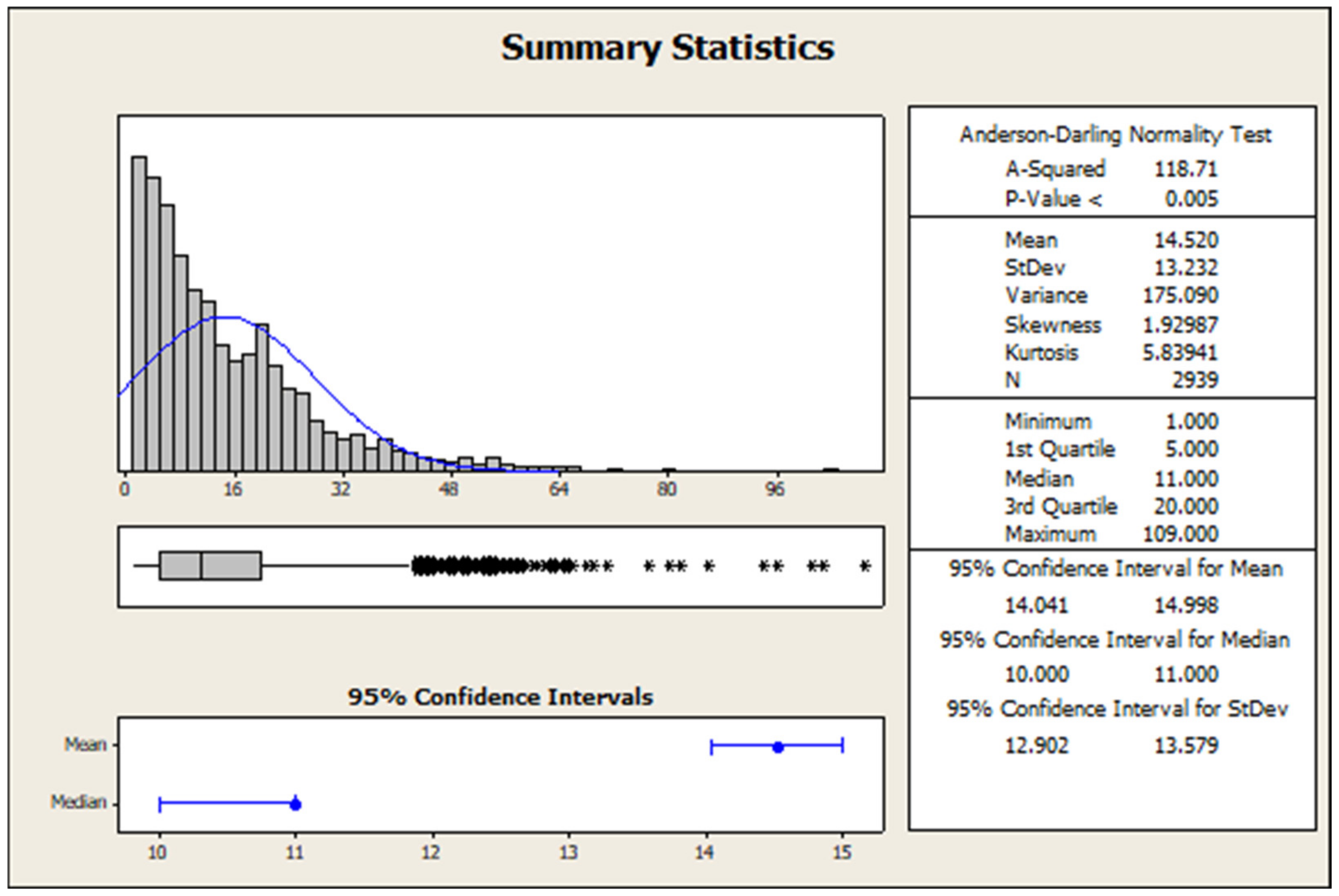
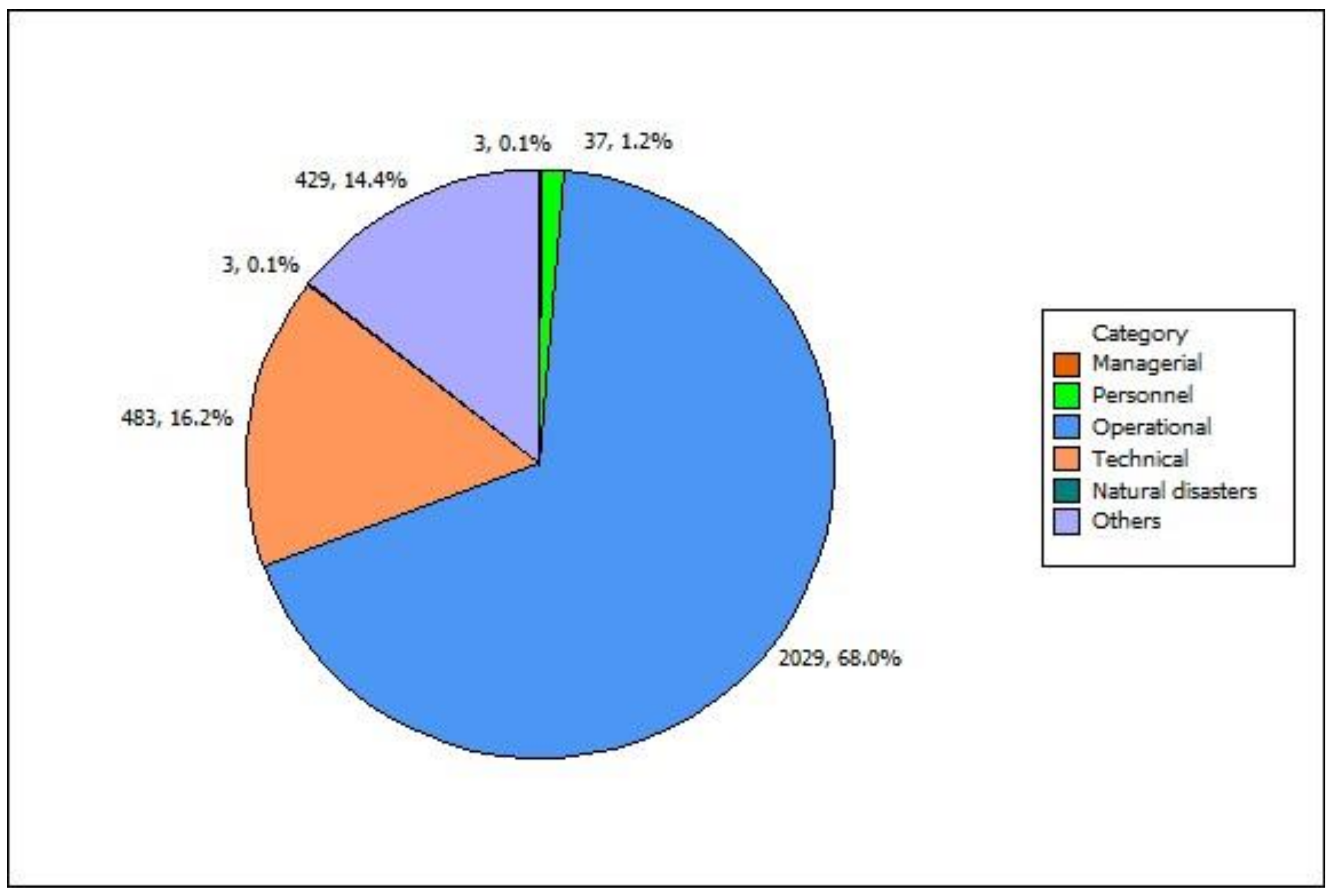
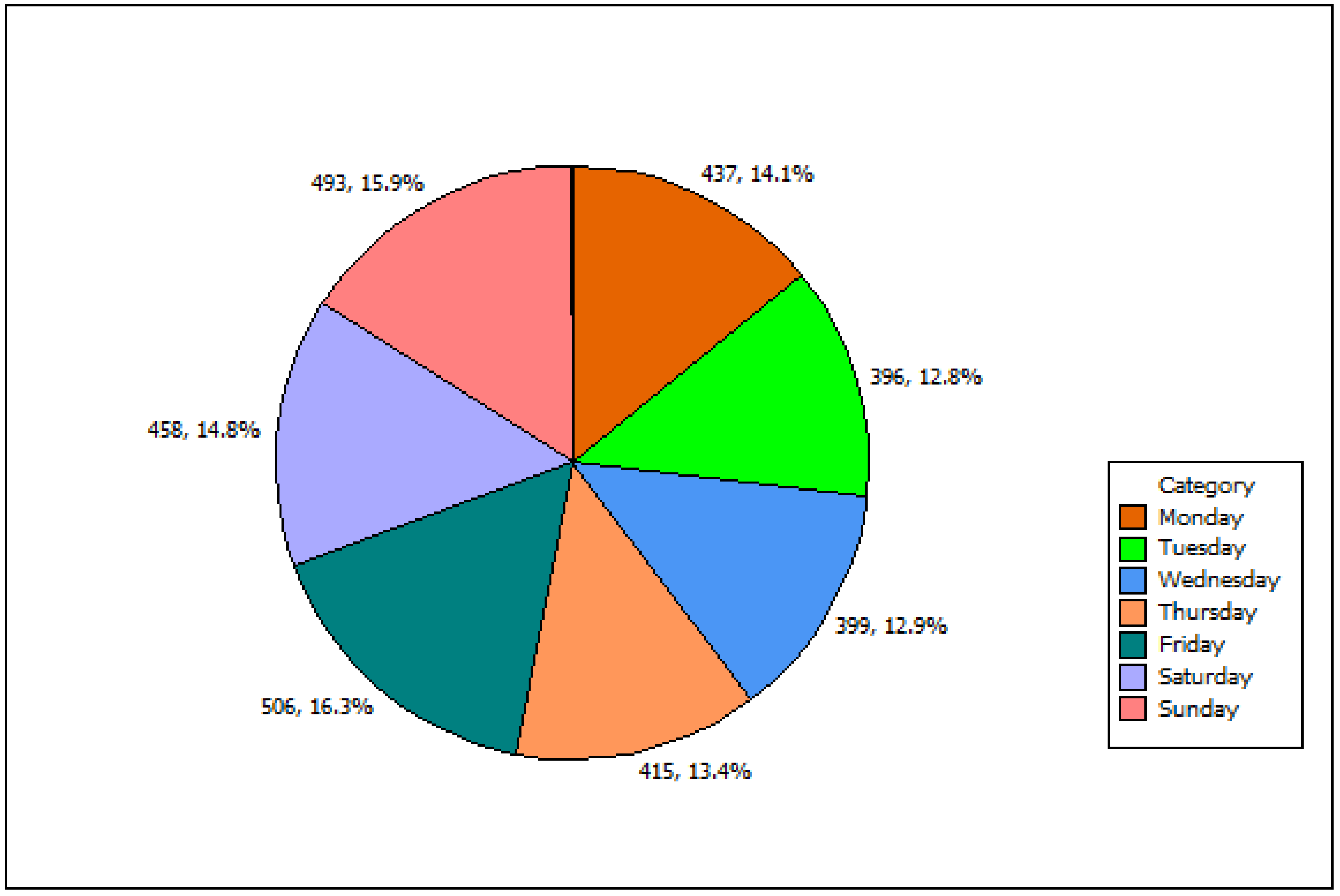
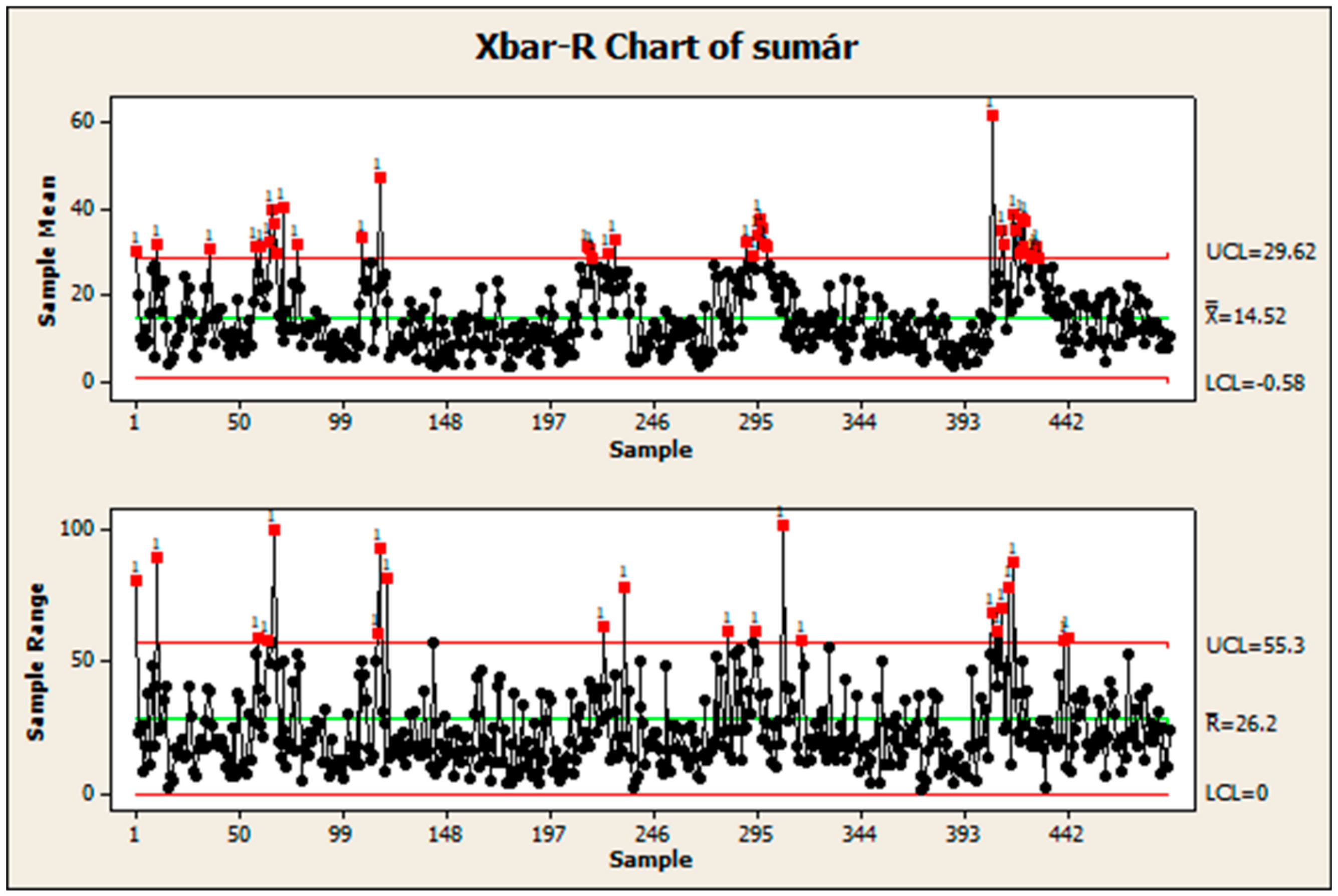
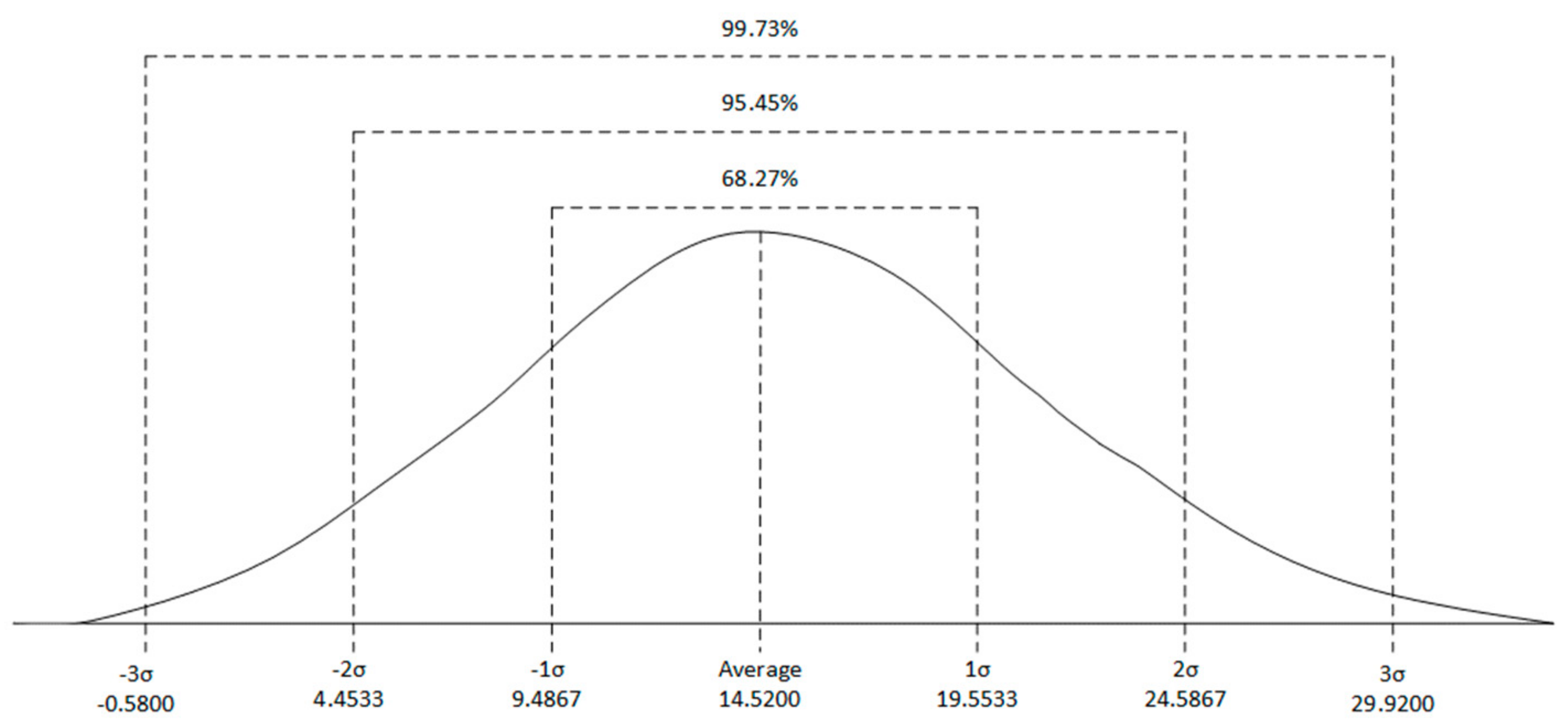
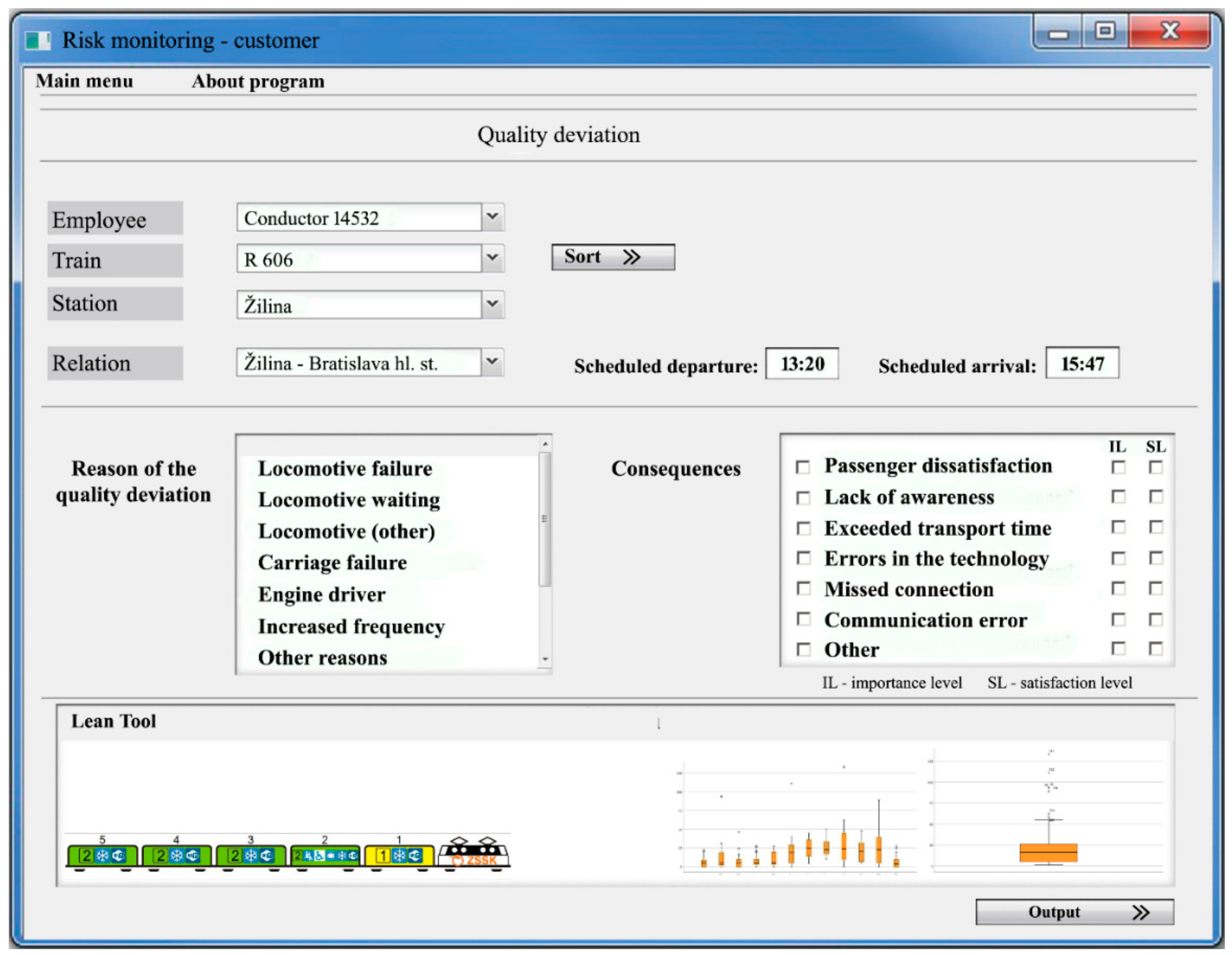
| Variable | μ | σ | Q1 | Q2 | Q3 | R | S | K | N |
|---|---|---|---|---|---|---|---|---|---|
| Žilina | 13.92 | 12.229 | 6 | 11 | 19 | 93 | 2.33 | 9.16 | 338 |
| Púchov | 15.59 | 14.911 | 5 | 11 | 21 | 99 | 1.99 | 5.01 | 305 |
| Trenčín | 11.69 | 11.607 | 3 | 9 | 16 | 102 | 2.4 | 9.87 | 619 |
| Leopol | 14.93 | 12.924 | 4 | 12 | 22 | 78 | 1.4 | 2.51 | 374 |
| Trnava | 14.07 | 12.643 | 5 | 10 | 20 | 101 | 1.9 | 5.36 | 792 |
| Ba Hln | 18.11 | 14.832 | 6 | 16 | 25 | 108 | 1.64 | 4.8 | 511 |
| Žilina | Púchov | Trenčín | Leopoldov | Trnava | Bratislava | |
|---|---|---|---|---|---|---|
| Žilina | 1 | |||||
| Púchov | 0.122639 | 1 | ||||
| Trenčín | 0.144155 | 0.151842 | 1 | |||
| Leopoldov | 0.018356 | 0.211284 | 0.023151 | 1 | ||
| Trnava | 0.005566 | 0.002551 | 0.077198 | 0.119126 | 1 | |
| Bratislava | 0.012897 | 0.060732 | 0.150343 | 0.175441 | 0.178172 | 1 |
| Error | Absolute Count | Relative Count | ||
|---|---|---|---|---|
| Count | Cumulative Count | Count | Cumulative Count | |
| Sequence of trains | 314 | 314 | 0.105263 | 0.105263 |
| Connection train | 178 | 492 | 0.059671 | 0.164935 |
| Unknown impact | 19 | 511 | 0.006369 | 0.171304 |
| Waiting for a tractive vehicle | 8 | 519 | 0.002682 | 0.173986 |
| Other reasons, transport | 9 | 528 | 0.003017 | 0.177003 |
| Other reasons, tractive vehicles | 19 | 547 | 0.006369 | 0.183372 |
| Other reasons, building | 10 | 557 | 0.003352 | 0.186725 |
| Other reasons, special | 403 | 960 | 0.135099 | 0.321824 |
| Loading and unloading - others | 6 | 966 | 0.002011 | 0.323835 |
| Accident events | 7 | 973 | 0.002347 | 0.326182 |
| Turnover | 9 | 982 | 0.003017 | 0.329199 |
| Failures of tractive vehicles | 53 | 1035 | 0.017767 | 0.346966 |
| Failures of passenger wagons | 46 | 1081 | 0.015421 | 0.362387 |
| Exceeding of travelling times | 435 | 1516 | 0.145826 | 0.508213 |
| Preparation | 5 | 1521 | 0.001676 | 0.509889 |
| Government authorities | 4 | 1525 | 0.001341 | 0.51123 |
| Train crews (conductor, train attendant) | 33 | 1558 | 0.011063 | 0.522293 |
| Driver | 7 | 1565 | 0.002347 | 0.52464 |
| Impact of weather | 10 | 1575 | 0.003352 | 0.527992 |
| Interlocking plants | 24 | 1599 | 0.008046 | 0.536038 |
| Equipment of electric traction | 17 | 1616 | 0.005699 | 0.541737 |
| Increased frequency | 1344 | 2960 | 0.450553 | 0.99229 |
| Superstructure | 12 | 2972 | 0.004023 | 0.996312 |
| Other reasons, carriage | 4 | 2976 | 0.001341 | 0.997653 |
| Other reasons, commercial | 1 | 2977 | 0.000335 | 0.997989 |
| Grade crossing interlocking plants | 6 | 2983 | 0.002011 | 1 |
© 2020 by the authors. Licensee MDPI, Basel, Switzerland. This article is an open access article distributed under the terms and conditions of the Creative Commons Attribution (CC BY) license (http://creativecommons.org/licenses/by/4.0/).
Share and Cite
Nedeliakova, E.; Hudakova, M.; Masar, M.; Lizbetinova, L.; Stasiak-Betlejewska, R.; Šulko, P. Sustainability of Railway Undertaking Services with Lean Philosophy in Risk Management—Case Study. Sustainability 2020, 12, 5298. https://doi.org/10.3390/su12135298
Nedeliakova E, Hudakova M, Masar M, Lizbetinova L, Stasiak-Betlejewska R, Šulko P. Sustainability of Railway Undertaking Services with Lean Philosophy in Risk Management—Case Study. Sustainability. 2020; 12(13):5298. https://doi.org/10.3390/su12135298
Chicago/Turabian StyleNedeliakova, Eva, Maria Hudakova, Matej Masar, Lenka Lizbetinova, Renata Stasiak-Betlejewska, and Peter Šulko. 2020. "Sustainability of Railway Undertaking Services with Lean Philosophy in Risk Management—Case Study" Sustainability 12, no. 13: 5298. https://doi.org/10.3390/su12135298
APA StyleNedeliakova, E., Hudakova, M., Masar, M., Lizbetinova, L., Stasiak-Betlejewska, R., & Šulko, P. (2020). Sustainability of Railway Undertaking Services with Lean Philosophy in Risk Management—Case Study. Sustainability, 12(13), 5298. https://doi.org/10.3390/su12135298





